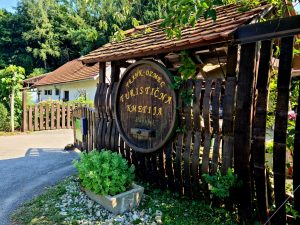Rural Hungary is littered with little towns and villages that don’t seem to offer much by way of interest and entertainment until you venture off the road and do your research. Zalaszabar is a case in point.
We drove through Zalavár, home of the bale bunnies, and across the dyke and its fishermen and its ancient monastic ruins, before turning left and heading into Zalaszabar and then taking a right to make our way back into the hills.


Zalaszabar is part of the Zala wine route. As we climbed up the hills we passed lots of little vineyards and old cellars, some neglected, others in good nick. Wild rose bushes were all over the place. I found one little house for sale that I’d like, had it some grapevines that came with it, and I wasn’t on the verge of another renovation. I made note of the number if anyone is interested. According to the village website, back in the 1890s, Sabar wine was awarded a gold medal at the London Wine World Exhibition. We made note of a few we’d like to visit.


Near the end of the narrow road we’d travelled are two towers. Sadly, the place was littered with other people’s rubbish and the day was hazy so the view of the Balaton and Badacsony wasn’t great. Another note was made to come back on a clear day with some bin bags. Still, as we sat on a wall looking down over the valley, the change of view was lovely – just what I needed.



On our way back we detoured to have a look at Zobori adventure park which is set for a soft opening this weekend. I wish them well. A third note was made to come back for a go on the hullámvasút (rollercoaster). It’s quite the enterprise. I’d seen the signs but had never been curious enough to check it out.
There’s a fabulous full-sized wooden carving of St Rita, near the bus stop in the village. St Rita of Cascia was an Italian widow who became an Augustinian nun. She’s the patron saint of sterility, abuse victims, loneliness, marriage difficulties, parenthood, widows, the sick, bodily ills, and wounds. She’s also the patron saint of impossible dreams. I’ve no idea how she found her way to this small Hungarian village, but there are stories online of her connections to Texas oil and baseball. Isn’t it amazing the reach these saints have? I doubt there’s a village in the country that doesn’t have a statue somewhere to someone and each has to have a story behind it.

But for all that, I still missed out on what the village is arguably most famous for: it’s home to the first public statue of the great football player Ferenc Puskás. Yet another note made.
Share this:
- Click to share on X (Opens in new window) X
- Click to share on Facebook (Opens in new window) Facebook
- Click to share on Pinterest (Opens in new window) Pinterest
- Click to share on LinkedIn (Opens in new window) LinkedIn
- Click to share on Reddit (Opens in new window) Reddit
- Click to share on WhatsApp (Opens in new window) WhatsApp
- Click to share on Pocket (Opens in new window) Pocket
- Click to share on Telegram (Opens in new window) Telegram
- Click to email a link to a friend (Opens in new window) Email







One Response